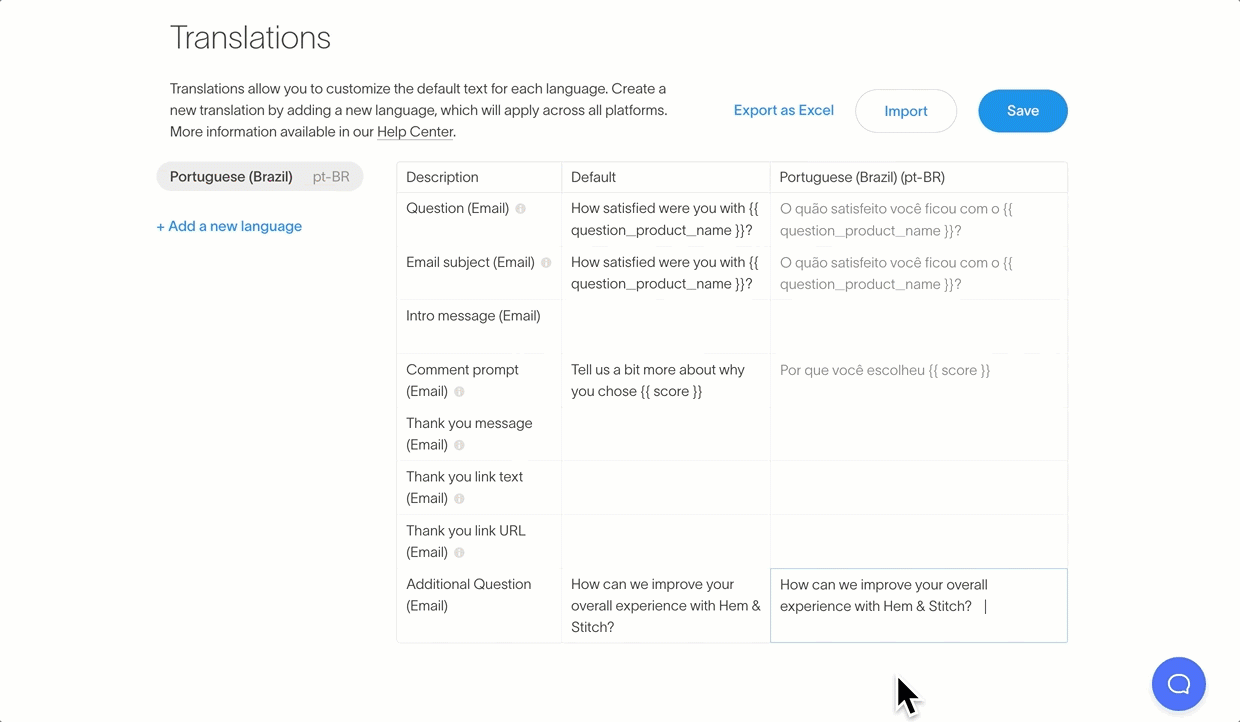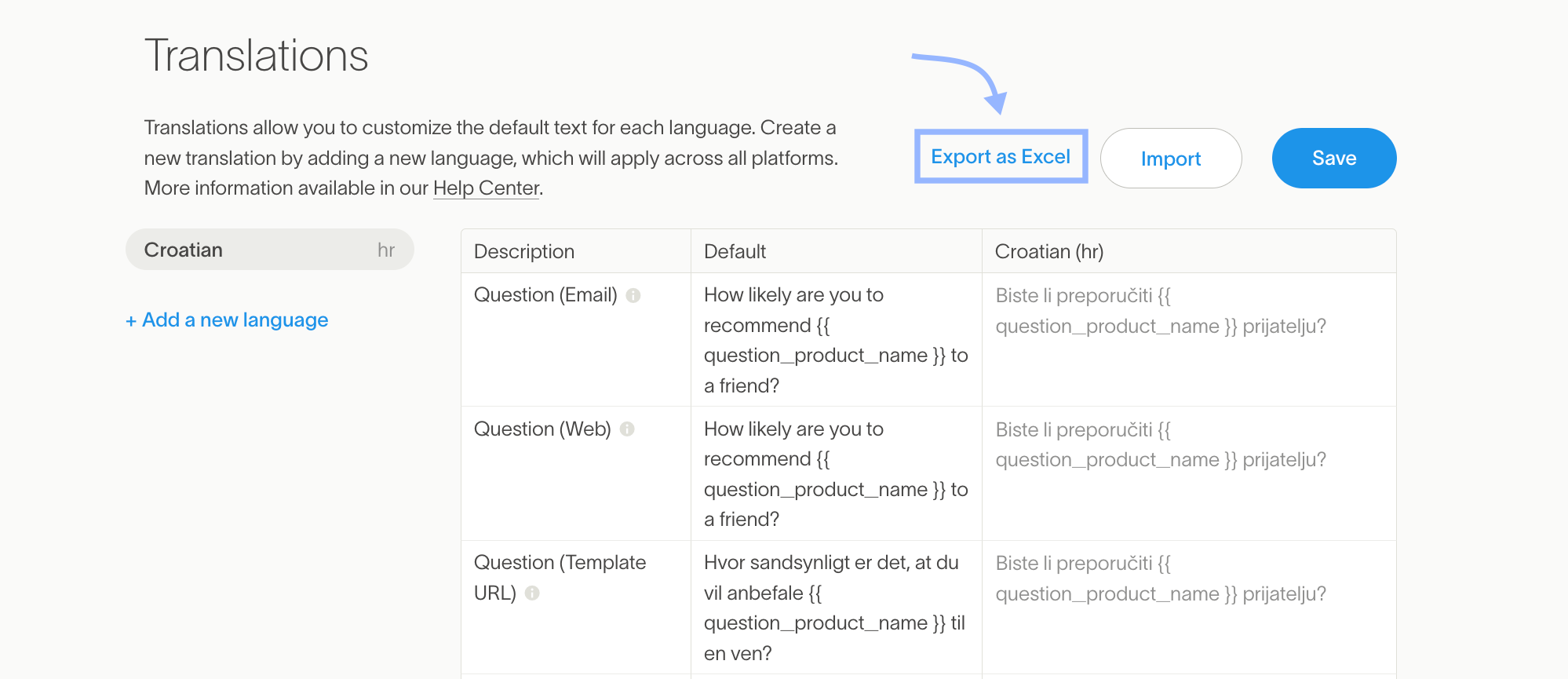Translating Your CX Projects
In this article:
FAQs
Suggested next article: Passing Properties
Introducing translation in CX
Speak directly to any audience with built-in translations — and even add custom translations of your own! You can:
| 1 | Apply a new language as your default translation |
| 2 | Add, customize, and edit new translations |
| 3 | Translate dynamically for individual recipients with the “locale” property |
1. Applying a new language as your default translation
Translate your survey in a snap by picking a new default language from the dozens of choices in the "Survey language" list. The list is found in the "Intro message and translation" panel on the “Primary questions” page — as seen here.
-
CX projects must be translated for each platform separately.
To change the language for a platform's survey:
- 1
- Click "Edit and send"
- 2
- Choose the "Gear" icon and "Edit survey" for Email → or the "Pencil" icon for other platforms (ex. Web & Link)
-

- 3
- Open “Intro message and translation”
- 4
- Choose the desired language from the dropdown list → ex. "Czech"
- 5
- Click “Save changes”
-

2. Adding, customizing and editing new translations
You may need to tweak the translation we provide. Do so with our Translations tool.
-
Premium feature The ability to build custom locales with the Translations tool is a premium feature. Check out our Pricing page.
To edit a translation:
- 1
- Open the Edit Project drop-down menu → and select "Edit Translations"

- 2
- Click “+Add a new language” → and choose the survey language you'd like to edit
-

- 3
- Type over the default translation to adjust it
- 4
- Click "Save" when you're finished!
-
Use the Translations tool for secondary languages
The Translations tool is only necessary to translate secondary versions of the survey across multiple languages.
If you’re translating to a single language, there is no need to use the Translations tool; use the list is found in the "Advanced customization" panel on the “Customize appearance” page instead. - 1
-
Open the Projects drop-down menu → and select "Edit Translations"
- 2
- Click “+Add a new language” → and select the language you want to translate
- 3
- Click “Export as Excel”
- 4
- Edit the translation → and save your updated file. (Make sure to edit in the column with the targeted language code → ex. pt-BR for Portuguese-Brazilian)
-

- 5
- Back in the Delighted Translations tool, make sure your desired language is selected and click “Import” at the top of the page → and Open your edited file.
- 6
- Watch as your custom translation is applied → and then click “Save”
-

Exporting and importing custom translations
You can also create custom translations outside of Delighted and import them into the platform (for example, if you use an external translation service). To do this:

3. Translating dynamically for individual recipients with the "locale” property
What if some recipients need the survey in one language and other recipients in another?
The special property “locale” can adjust the localization (language) for each recipient. We use the ISO 639-1 Code for each language to identify the correct translation.
For example, use locale = fr to send your survey to Adele in French, and locale = es to send your survey to Andres in Spanish! See the Available languages section to find your code.
What it looks like as a property
| CSV | Column header titled Locale |
| API | properties[ locale ]=Value |
| Web | { locale: “Value” } |
| Link | ? locale=Value |
| Kiosk | + Add property Locale |
Read all about Special Properties and how to pass them in this article.
Available languages
We currently support over three dozen languages:
| Language | Locale |
| Arabic Bulgarian Chinese (Simplified) Chinese (Traditional, Hong Kong) Chinese (Traditional, Taiwan) Croatian Czech Danish Dutch English Estonian Finnish French Georgian German Greek Hebrew Hungarian Indonesian Italian Japanese Korean Latvian Lithuanian Malaysian Norwegian Bokmål Polish Portuguese (Brazil) Portuguese (Portugal) Romanian Russian Serbian Spanish Swedish Thai Turkish Vietnamese |
ar bg zh-CN zh-HK zh-TW hr cs da nl en et fi fr ka de el he hu id it ja ko lv lt ms nb pl pt-BR pt ro ru sr es sv th tr vi |
We use the ISO 639-1 codes for each language as the locale value. You can also find the full list of the languages and their associated language codes in the Advanced Customization section of any survey customization page.
What parts of my CX project can be translated?
When you change the language of your project, the entire survey-taker experience will be updated to the new language, from the scale labels to the Thank you page.
However, any parts of the survey that you have added or customized, such as Additional Questions, will need to be translated manually using the Translations tool.
Can I translate my Additional Questions?
Yes! After adding Additional Questions to your survey, you’ll see them appear in the Translations tool as a field to edit when adding a new language.






